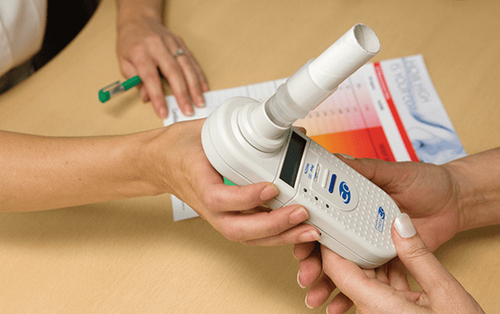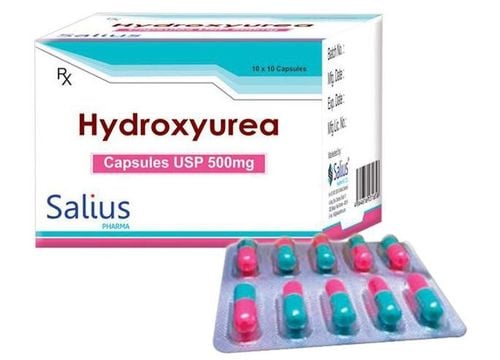This is an automatically translated article.
Droxia, the active ingredient hydroxyurea, is used in patients with sickle cell anemia. The drug is available in capsule form and is available in concentrations of 200 mg, 300 mg and 400 mg of hydroxyurea.1. What effect does Droxia have?
Droxia is used by people with sickle cell anemia to reduce the amount of pain caused by the disease and reduce the need for blood transfusions. In addition, the drug is also used in the treatment of certain types of cancer (such as chronic myeloid leukemia, squamous cell carcinoma).2. Indications for use
Droxia is indicated for the reduction of pain frequency and the need for blood transfusion in patients with sickle cell anemia with moderate to severe recurrent pain.3. How to use the drug Droxia
Patients should read the leaflet provided by the pharmacist before you start taking Droxia . If you have any unanswered questions, consult your doctor or pharmacist.Droxia is to be taken by mouth, with or without food as directed by your doctor, usually once daily. Dosage is based on the patient's weight, medical condition, test results, and response to treatment. A patient's treatment may be stopped for a short time if the blood count is too low. Patients should keep all medical and laboratory appointments.
Patients should not arbitrarily increase the dose or use Droxia more often or for longer than prescribed. The patient's condition will not improve any faster and the risk of serious side effects will increase.
With the capsule dosage form, the patient should swallow the tablet whole. Do not crush, chew or open the tablet.
Inform your doctor if the condition does not improve or gets worse.

Người bệnh không nhai nát hoặc mở viên thuốc khi uống thuốc Droxia
4. Drug interactions
Drug interactions can change the way a drug works or increase the risk of serious unwanted effects. The article does not cover all possible drug interactions. Patients should keep a list of all products they are taking (including prescription drugs, over-the-counter medicines, and herbal products) and share it with their doctor or pharmacist for further advice. Patients should not arbitrarily start, stop or change the dosage of any medication without the advice of the treating doctor.Some products that may interact with Droxia include: Didanosine, nalidixic acid, stavudine.
Droxia may interfere with certain laboratory tests leading to false test results. Make sure that laboratory staff and all physicians know the patient is taking Droxia .
5. Note about side effects of Droxia and precautions when using it
5.1. Undesirable effects Possible side effects include nausea, vomiting, loss of appetite, mouth sores, diarrhea or constipation. If any of these effects persist or become worse, notify your doctor or pharmacist immediately for prompt treatment.Patients taking Droxia may experience serious side effects. However, the doctor prescribed the drug because they judged that the benefit to the patient outweighed the risk of unwanted effects. Careful monitoring by your doctor can reduce the risk of these side effects.
Notify physician immediately if patient experiences any serious side effects, including: skin problems (such as ulcers; darkening, darkening, or redness of the skin), mood changes, mental status (such as confusion, hallucinations), seizures, trouble breathing, signs of kidney problems (such as change in the amount of urine).
Get medical help right away if a patient has any very serious side effects, including: Chest pain c .
Very serious allergic reactions to the use of Droxia are very rare. However, patients or family members should seek immediate medical help if they notice any symptoms of a serious allergic reaction, including: Rash, swelling and itching (especially of the face, tongue, throat), difficulty breathing, severe dizziness.
The above is not a complete list of all possible undesirable effects. If you notice any other effects not listed above, contact your doctor or pharmacist for further advice.

Buồn nôn, nôn là tác dụng phụ không mong muốn của thuốc Droxi
Before using Droxia, tell your doctor or pharmacist your medical history, especially of: Kidney disease, liver disease, blood or bone marrow disorders (such as bone marrow suppression, leukopenia , thrombocytopenia, anemia), HIV infection, high blood uric acid levels, being treated with radiation therapy.
Hydroxyurea may make the body more susceptible to infection or may worsen existing infections. Contact with people who have an infection that can be spread to others (such as chickenpox, measles, or flu) should be minimized as much as possible.
Do not self-immunize without the consent of the doctor, and at the same time, the patient should avoid contact with people who have received a live vaccine recently (eg influenza vaccine inhaled through the nose).
Before surgery, tell your doctor or dentist about all the products you are using (including prescription drugs, over-the-counter medicines and herbal supplements).
Older adults may be more sensitive to the side effects of Droxia .
It is not known whether Droxia affects sperm or not. Male patients planning to have children need to discuss the benefits and risks of Droxia with their doctor in order to choose the right treatment.
Patients should inform their doctor if they are pregnant or planning to become pregnant. Patients should not become pregnant while using hydroxyurea because hydroxyurea can harm the unborn baby. Men with female partners of childbearing age should consult about reliable forms of birth control while using Droxia and for 1 year after stopping treatment. Women of childbearing age should consult about reliable forms of contraception while using Droxia and for 6 months after stopping treatment.
Hydroxyurea may be excreted in breast milk and cause undesirable effects on the infant. Breastfeeding while using Droxia is not recommended. Patients should consult their doctor before breast-feeding.
Please dial HOTLINE for more information or register for an appointment HERE. Download MyVinmec app to make appointments faster and to manage your bookings easily.
Reference sources: Webmd.com, eMC, DailyMed












